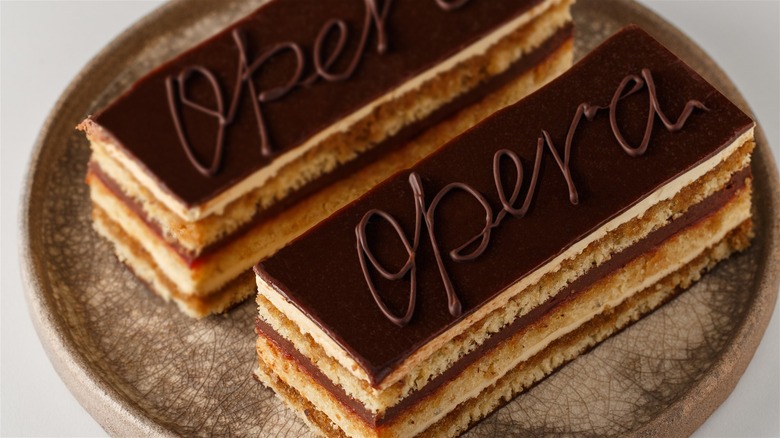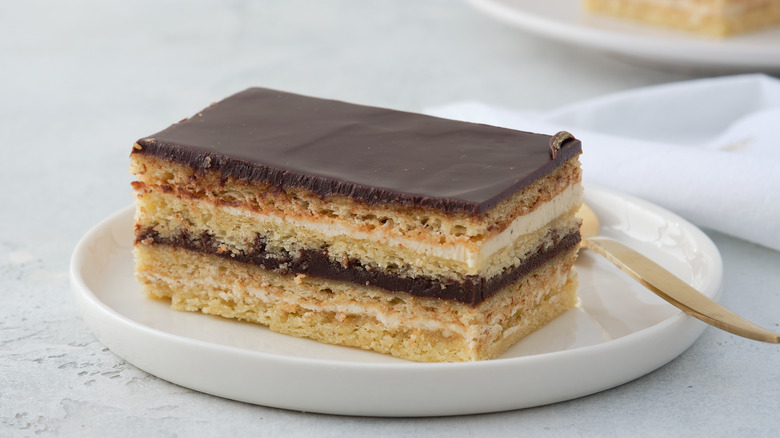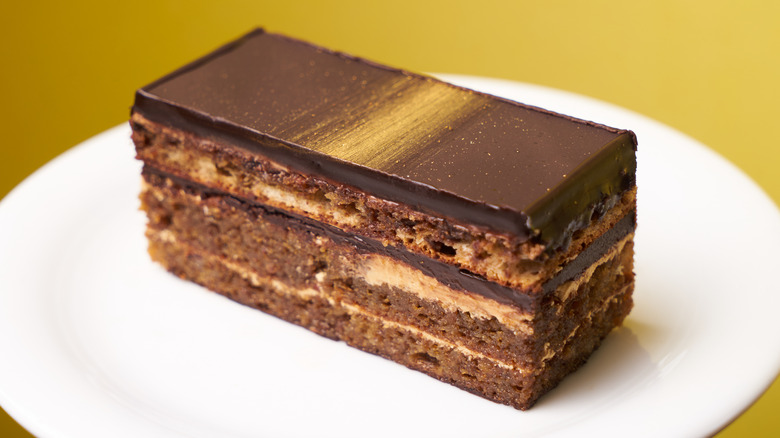What Is French Opera Cake And What Does It Taste Like?
French patisserie is an art form. A celebration of skill and sweet flavors, French cakes are as much a feast for the eyes as they are for your taste buds. This is particularly evident in the French Opera cake. Also known as L'Opéra, French Opera cake has romantic beginnings in the prestigious bakery of Dalloyau in Paris. The history of Dalloyau actually began in 1682, when Charles Dalloyau served as a baker for Louis XIV and the Royal Court of Versailles. Over the next few centuries, descendants of Charles Dalloyau served multiple royal lines (Marie-Antoinette included), navigated the French Revolution, and in 1802, opened the first "Maison de Gastronomie." This developed into the legendary Dalloyau bakery and patisserie.
Fast forward another century and a half to 1955, and it's believed that L'Opéra was conceived within the very same bakery. It's a small, rectangular-shaped cake that showcases clear layers in varying hues of hazel. The cake is typically composed of almond cake soaked in boozy coffee syrup, heavenly thick coffee buttercream, and rich, dark chocolate ganache. It's decadent and luxurious.
With six to eight striking layers, L'Opéra is a marvel to behold. The buttercream gives the cake that velvety smoothness, while the coffee syrup adds a mildly bitter undertone. In one bite, this cake bursts into a symphony of flavors, with nutty, sweet, and coffee notes playfully harmonizing in a delightful ensemble. This cake tastes as clever and impressive as it looks.
A brief history of the French Opera cake
Similar to the captivating story behind tres leches cake, there lies an intriguing narrative behind L'Opéra. It's believed that L'Opéra was first invented by Cyriaque Gavillon, a pastry chef at the legendary Dalloyau in 1955. A rather romantic version of the tale recounts how, on tasting the cake, Gavillon's wife proclaimed that it reminded her of the Paris Opera. Its taste mirrored the opera's sophistication and magnificence. Dalloyau, however, claims that Cyriaque created the cake in honor of the "petit rats," or child ballet students of the Paris Opera House.
Yet, others attribute L'Opéra's origins to Louis Clichy, who is believed to have presented a layered cake similar to L'Opéra in 1903 at a culinary exposition. While its beginnings may forever be contested, one thing you cannot disagree with is how incredible this cake is. With lusciously layered buttercream, cake, and ganache, L'Opéra became a fast favorite in French patisseries and is now regarded as a classic.
Each layer a decadent affair
Just like the layers of the Marjolaine cake, every layer in L'Opéra is skillfully constructed. Its small size and thin layers are crucial to tasting every heavenly layer in one bite. The almond cake, also called joconde, is astonishingly light and airy, especially as its rise is solely attributed to the air whisked into the eggs. Sliced into three layers, this almond cake is brushed generously with a coffee syrup infused with a subtle kick from brandy, rum, amaretto, or Cointreau.
Layered atop the almond cake is thick, whipped coffee buttercream. The bitter coffee balances the sweetness of the cream. Yet, with coffee-soaked cake and coffee buttercream, one may assume that this cake is leaning too far over the bitter line, but that's precisely where the dark chocolate ganache comes into play. This layer balances those bitter notes to leave you with a sophisticated, sweet, decadent mouthful.
L'Opéra is typically garnished with the word "Opera" piped in chocolate over the top and cut into small bars that showcase the beautiful layers. Just as an opera singer must harmonize with the orchestra, so does this cake with its flavors. If you ever get the chance to try it, L'Opéra is music for your taste buds.


